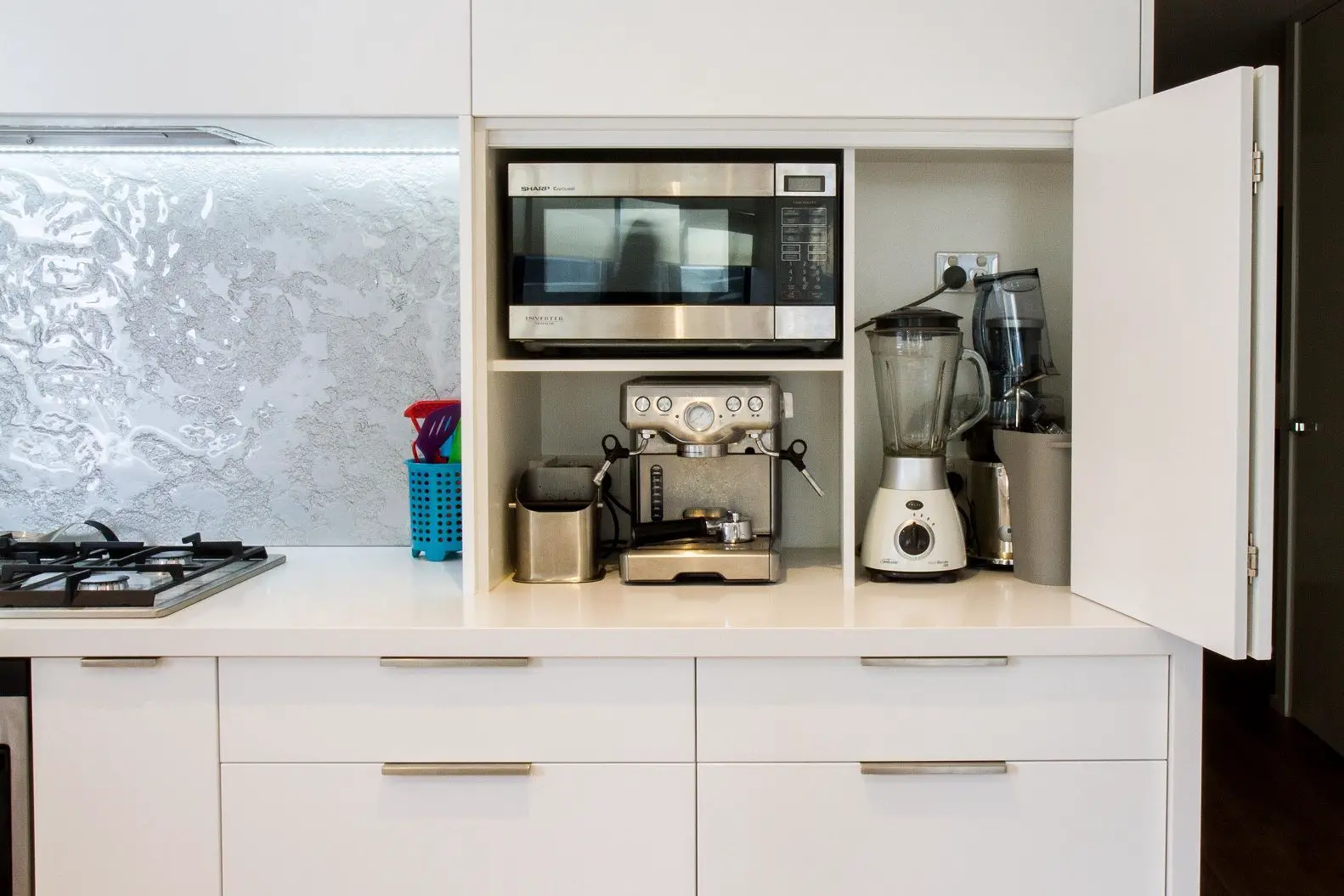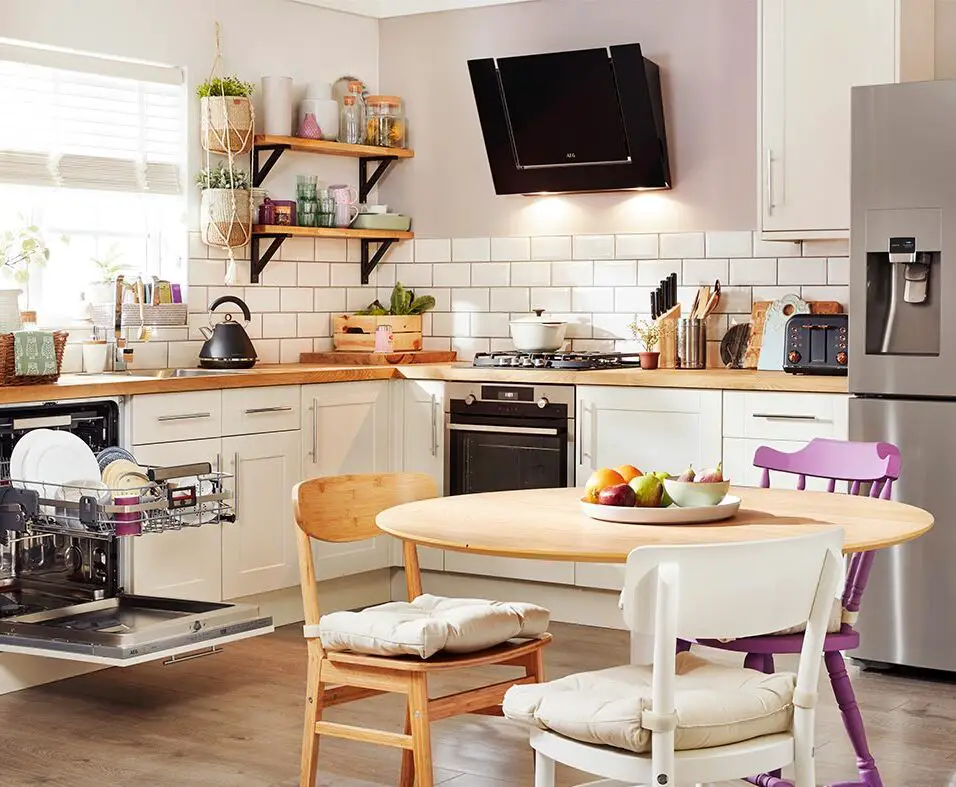How To Organize Kitchen Appliances
Introduction
How To Organize Kitchen Appliances: From blenders and toasters to coffee makers and food processors, the array of kitchen appliances can quickly become overwhelming if not properly organized. Practical and efficient strategies to arrange your kitchen appliances, maximizing both accessibility and aesthetics. Whether you’re a cooking enthusiast or someone looking to optimize their kitchen space, these tips will help you declutter, categorize, and create a harmonious environment for your culinary adventures.
Place the most frequently used appliances within easy reach on your kitchen cabinet. These might include your coffee maker, toaster, or microwave. Items used less frequently, like large mixers or specialty gadgets, can be stored in lower cabinets or higher shelves. Make the most of your kitchen’s vertical space by using wall-mounted shelves or hooks to hang smaller appliances like blenders, hand mixers, or cutting boards. This not only saves countertop space but also gives your kitchen a neat and visually appealing look.
For smaller appliances or gadgets that might clutter the countertop, consider using drawer dividers or small bins to keep them organized within cabinets. This prevents them from getting lost or tangled up. If you have multiple similar-looking gadgets or small parts, use labels or clear containers to identify and differentiate them. This makes it easier to locate what you need quickly.
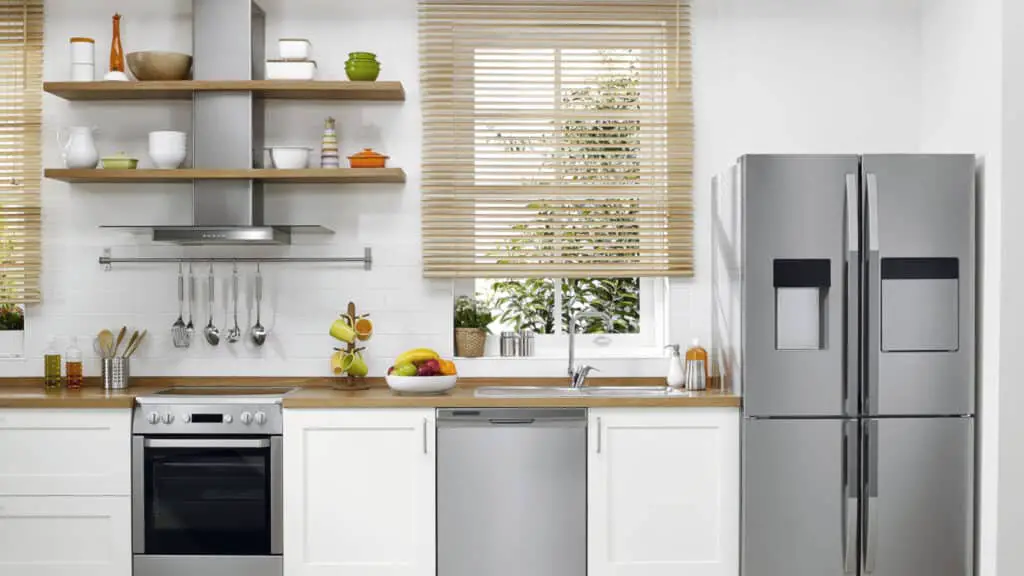
How do I organize my kitchen like a pro?
How to organize your kitchen like a chef – 8 pro tips to cook…
- ‘Everything in its place’
- Create specific zones.
- Focus on the space around your oven.
- Separate your table salt and your cooking salt.
- Consider where you store your spices.
- Prioritize visibility and accessibility.
- Make the most of your drawer space.
The first step in organizing your kitchen like a pro is decluttering. Go through your cabinets, drawers, and countertops and remove items you no longer use or need. Assess the condition of your kitchen tools and appliances, discarding or donating any broken or outdated items. Reducing clutter will create more space and make it easier to organize the essentials.
Next, categorize your kitchen items based on their functionalities. Create zones for food preparation, cooking, baking, and serving. Store items related to each zone in close proximity to one another, making the cooking process smoother. For instance, keep cutting boards, knives, and food processors together in the food prep zone.
Utilize cabinet space efficiently by incorporating adjustable shelves and pull-out organizers. Store frequently used items at eye level for easy access. Install dividers and bins inside cabinets to keep smaller items neatly arranged and prevent clutter.
Drawer dividers are essential for keeping utensils, cooking tools, and gadgets organized. Divide drawers based on item categories, such as one for cooking utensils, another for baking tools, and a separate one for serving spoons and tongs.
Take advantage of vertical space by installing wall-mounted racks, hooks, or shelves. Hang pots, pans, and frequently used utensils on the wall near the cooking area for quick access. This not only saves space but also adds a rustic and professional touch to your kitchen.
What is the most efficient way to organize a kitchen?
Organize in Zones
A popular way to divide up a kitchen is to use zones. With zones, you store similar items together in areas of the kitchen that make the most sense. For example, you can store glassware and bowls next to the dishwasher, which will make it easier to empty it after a cycle is complete.
The foundation of an efficiently organized kitchen starts with decluttering. Go through your cabinets, pantry, and countertops, and remove any unused, broken, or duplicate items. Donate or discard appliances, gadgets, and tools that no longer serve a purpose. Decluttering will create more space and make it easier to organize the essentials effectively.
Divide your kitchen into functional zones, such as food preparation, cooking, baking, and storage. Store related items in each zone to minimize unnecessary movement and optimize workflow. For example, keep cutting boards, knives, and mixing bowls together in the food prep zone.
Utilize cabinet and drawer space efficiently by implementing a strategic layout. Install adjustable shelves to accommodate various item sizes and use drawer dividers to keep utensils and tools neatly organized. Reserve the prime real estate, such as eye-level cabinets and easily accessible drawers, for frequently used items.
Incorporate smart storage solutions to maximize your kitchen’s efficiency. Utilize vertical space with wall-mounted shelves or racks for pots, pans, and cooking utensils. Install pull-out organizers in cabinets for easy access to stored items, and use clear containers for dry ingredients to easily identify and restock supplies.
Keep countertops clutter-free to create ample workspace. Limit the number of appliances and decorative items on display, reserving space for essential tools like cutting boards and knife blocks. Stow away less frequently used appliances in cabinets or on wall-mounted shelves.
How can I learn to organize?
Here are eight organizational tips that will help you reach your long-term goals at work.
- Focus on what’s important.
- Make lists.
- Manage your time well.
- Use calendars and planners.
- Delegate tasks.
- Manage your mail and phone calls.
- Reduce clutter.
- Stay organized.
Begin your organizing journey by starting small and setting achievable goals. Choose one area of your life or living space, such as a desk, closet, or digital files, to organize initially. Set realistic objectives for decluttering and organizing that specific area. Achieving these small victories will build momentum and motivate you to tackle more significant organizing challenges.
The first step to effective organization is decluttering. Assess your belongings, whether physical or digital, and let go of items you no longer need, use, or value. Embrace the “less is more” mindset, donating or discarding items that no longer serve a purpose in your life. Decluttering clears space for the things that truly matter and brings a sense of liberation.
Consistency is key to successful organization. Develop a systematic approach to organizing, whether it’s arranging items by category, using color-coded labels, or creating folders for digital files. Having a clear and consistent system in place simplifies daily tasks and helps maintain order over time.
Learning to organize also involves effective time management. Prioritize your tasks and commitments, using tools like to-do lists or digital calendars to keep track of deadlines and appointments. Allocate specific time slots for organizing, ensuring you dedicate time regularly to maintain your organized spaces.
What are skills to organize?
Organizational skills are your abilities to manage time effectively, prioritize tasks, set goals, and develop systems for achieving those goals. Employees with good organizational skills can juggle multiple responsibilities simultaneously, stay focused on deadlines, and handle complex projects efficiently.
Assign designated spaces for items based on their use and frequency. Store frequently used items in easily accessible areas, while less frequently used items can be kept in more remote locations. Creating designated spaces helps prevent clutter from spreading and allows for efficient retrieval of items when needed.
One of the fundamental skills to organize is time management. Learning to prioritize tasks, set deadlines, and allocate time effectively can help you accomplish more in less time. Use tools like to-do lists, calendars, or time-blocking techniques to structure your day and ensure that important tasks receive the attention they deserve.
The ability to declutter is essential for effective organization. Regularly assess your belongings, both physical and digital, and let go of items that no longer serve a purpose. Embrace the practice of minimalism to create more space and reduce distractions.
Organizing involves categorizing items based on their use or relevance. Develop the skill of categorization to group similar items together, making them easier to find and access when needed. Whether it’s arranging physical items in cabinets or organizing digital files into folders, categorization fosters order and efficiency.
Effective organization is goal-oriented. Define clear and achievable objectives for organizing specific areas of your life, such as your workspace, closet, or digital files. Setting goals provides direction and motivation to stay on track with your organizing efforts.
Creating a systematic approach to organizing is crucial for maintaining order. Develop consistent methods for arranging items, labeling, and storing them. Having a well-defined system simplifies organization and ensures continuity over time.
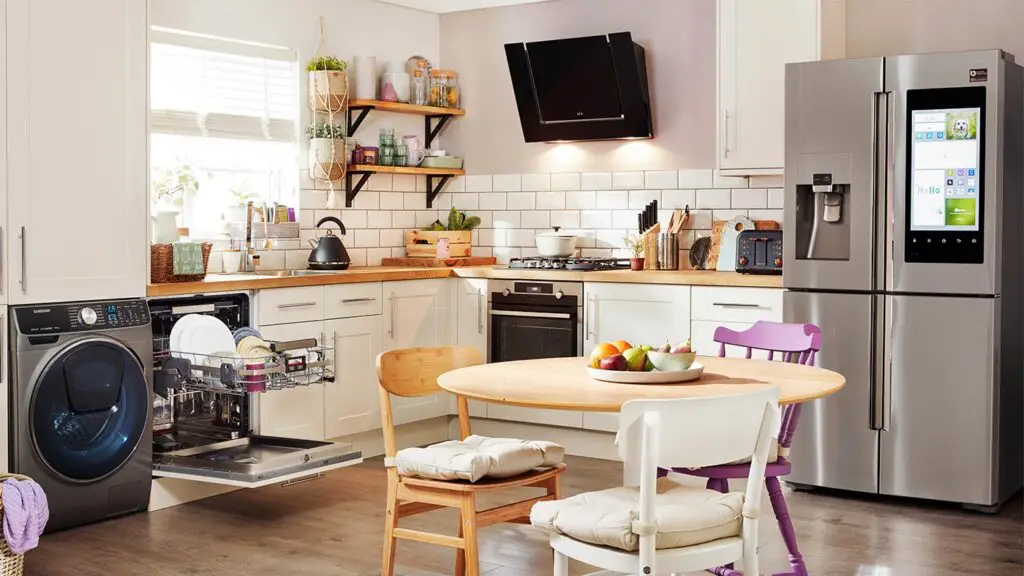
How do you arrange kitchen cups?
One of these storage ideas should be the perfect solution for your house!
- Display Mugs on Your Kitchen Wall.
- Use Hooks in Your Kitchen Cabinet to Hang Mugs.
- Add Shelf Risers to Your Shelves.
- Make a Coffee Station.
- Get Cubby Shelves.
- Show Off Your Favorite Mugs.
- Storing Mugs in a Cabinet by Stacking Them.
Select a designated storage area for your cups, such as a cabinet, shelf, or a dedicated cupboard. Choose a location that is easily accessible, preferably close to your coffee maker or tea station for convenience.
Maximize your kitchen’s vertical space by using hooks or shelves to hang cups. Installing hooks under cabinets or on a pegboard allows you to display and store cups in an aesthetically pleasing manner while saving valuable shelf space for other kitchen essentials.
If you have limited storage space, consider using stackable or nesting cups. These cups can be easily stored one inside the other, saving space and preventing clutter. Stackable cups also come in various sizes, making them versatile for different beverages.
Organize your cups based on their function or size. For example, you can group coffee mugs together, tea cups in another section, and drinking glasses in a separate area. This arrangement ensures that you can easily find the cup you need without rummaging through the entire collection.
If you have deep drawers in your kitchen, use drawer organizers to neatly store cups horizontally. This setup keeps cups secure and prevents them from tipping over or getting scratched.
Consider investing in a cup rack or a cup holder that can be mounted on the wall or placed on the countertop. A cup rack not only adds an attractive display but also keeps cups organized and easily accessible.
How do I organize my spices?
If you use a drawer, find a drawer organizer that stores the jars tilted and in tiers, or use a divider that will keep jars upright and corralled. If you’re short on enclosed storage space, hang racks or magnetic strips on the walls or underneath high cabinets. You can even stash spices in a shoebox or plastic bin.
Select a dedicated location for your spice storage, such as a cabinet, drawer, or spice rack. The chosen location should be easily accessible while avoiding exposure to direct sunlight or excessive heat.
Invest in a spice rack to neatly organize your spices in one place. Spice racks come in various designs, from countertop models to wall-mounted or revolving ones. Choose a rack that suits your kitchen’s style and complements your spice collection.
Categorize your spices based on usage or type. For example, group baking spices together, separate commonly used spices, and create a section for international or specialty spices. Within each category, alphabetize the jars for easy identification.
Opt for transparent spice jars to easily identify the contents. Clear jars allow you to see the spices’ colors and quantities at a glance, eliminating the need to open every jar while cooking.
Label each spice jar clearly with its name to prevent confusion. Consider using uniform labels or a label maker for a neat and organized appearance.
If you have a drawer available, use drawer organizers with compartments to store spice jars horizontally. This arrangement prevents the jars from tipping over and keeps them securely in place.
How do I organize my top kitchen cabinets?
Follow these steps to maximize storage space for dinnerware, cookware, utensils, cleaning supplies, and more:
- Place heavier items on the bottom of cabinet shelves.
- Keep like items together.
- Maximize the capacity of your cabinets.
- Use round storage organizers.
- Maximize vertical space.
- Use containers.
Before organizing, declutter your top kitchen cabinets. Take out all the items and assess their usefulness. Discard or donate items that you no longer need or use. Reducing clutter will create more space and make organizing more manageable.
Group similar items together based on their functionality. For instance, place baking supplies in one section, glassware in another, and cookware in a separate area. Categorizing items allows for easier retrieval and avoids mixing unrelated items.
Utilize clear storage containers for items with small components or loose parts, such as spices, baking decorations, or small utensils. Clear containers make it easy to identify contents and prevent items from spilling or getting lost in the back of the cabinets.
A sturdy step stool is essential for accessing the top kitchen cabinets. Keep the step stool nearby to reach items effortlessly and safely whenever needed.
Use the top cabinets to store seasonal or occasional items that you don’t use frequently. Holiday-themed serveware, festive decorations, or special occasion dinnerware can be safely stored in the top cabinets, freeing up prime space in lower cabinets.
Maximize vertical space by using shelf risers or stackable organizers. These solutions allow you to create multiple tiers within the top cabinets, making it easier to access items at different heights.
Which cabinet is best for kitchen?
Plywood: The highest quality kitchen cabinets are made of cabinet-grade multi-layer plywood. Plywood cabinets are strong, easier to install and considerably lighter in weight than MDF or particleboard cabinets. While more expensive, plywood cabinets are a good choice if you expect to own the house for a long period.
Consider installing pull-out organizers in the top cabinets. These organizers make it convenient to retrieve items by bringing them out to eye level, ensuring nothing gets lost or forgotten in the back of the cabinets.
Reserve the top cabinets for items that you don’t use on a daily basis. Store less frequently used appliances, special occasion china, or bulky cookware in these high spaces.
Labeling containers, bins, or jars can aid in identifying items quickly. Use a label maker or chalkboard labels to create a neat and organized appearance.
Regularly reassess the organization of your top cabinets and make adjustments as needed. Take a few minutes every few months to tidy up and ensure items are in their designated spaces.
Traditional and elegant, raised panel cabinets showcase a decorative center panel that adds dimension to the cabinet doors.
Also known as slab cabinets, flat-panel doors have a minimalist and contemporary appearance, perfect for modern kitchen designs.
Glass front cabinets offer an opportunity to display decorative items or dishware, adding a touch of sophistication to your kitchen.
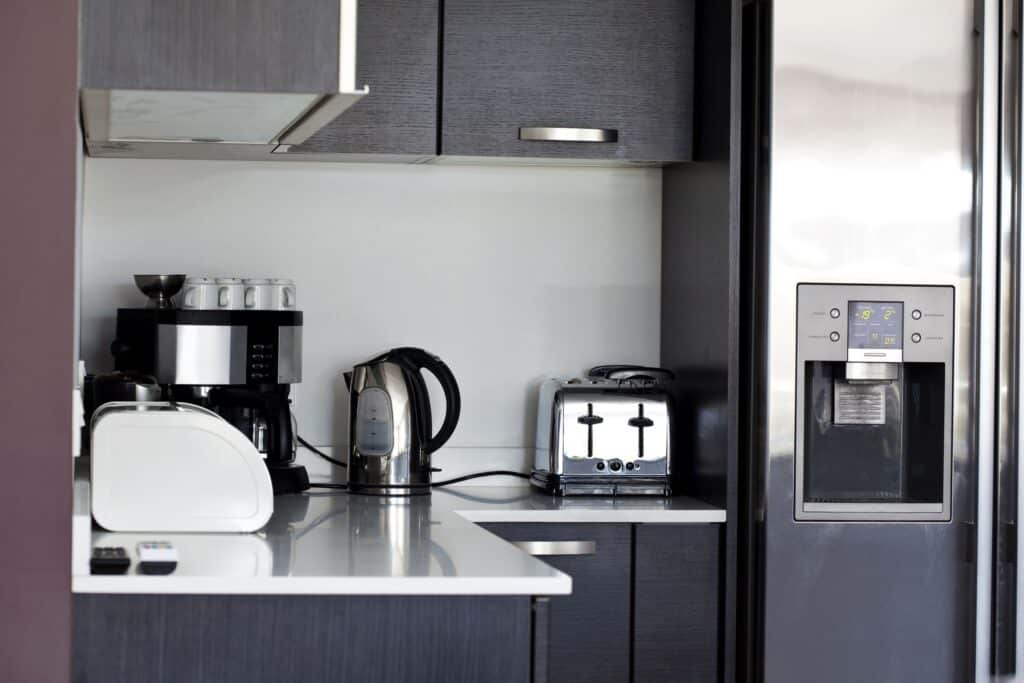
Conclusion
A well-organized kitchen allows for easy access to frequently used appliances, saving you precious time during meal preparation and making cooking a more enjoyable experience. The thoughtful placement of appliances on countertops, in cabinets, and on walls optimizes available space, giving your kitchen a tidy and visually appealing appearance. While organizing your kitchen appliances, keep safety in mind. Place heavy or large appliances on lower shelves or countertops to prevent accidents. Ensure that electrical appliances have proper grounding and are plugged into GFCI outlets. Additionally, store sharp objects like knives in secure holders to avoid injuries.
Categorizing appliances based on their functionalities helps streamline your workflow, ensuring that you have everything you need within arm’s reach in dedicated zones. Utilizing vertical space, employing drawer dividers, and implementing labeling systems bring an added layer of order to your kitchen, preventing clutter and enhancing accessibility. Organize your kitchen appliances in a way that complements your cooking workflow. For example, place kitchen appliances the cutting board and food processor in close proximity to the food prep area, making chopping and processing ingredients a seamless process.
Moreover, maintaining cleanliness and regularly reviewing your organization system are essential habits that ensure your kitchen remains an efficient and pleasant space to work in.Your kitchen appliances should reflect your personal preferences and lifestyle. Whether you’re a seasoned chef or a casual cook, customizing the organization process to suit your needs will create a kitchen that aligns with your unique cooking style.



